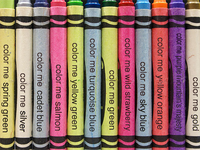Color Me
The phrase Color Me has been around for a number of years. Where does it come from? Good question, I couldn't find it either... After an extensive search using google and probably yahoo, I came across these references.
It is first thought to be used in the album title Color Me Barbra by Barbra Streisand; circa 1966. However, after more searching, I found this phrase shows up prior to the singer's album in the following two references:
"I Am the Night—Color Me Black" is an episode of the American television anthology series The Twilight Zone. Original airdate: March 27, 1964.
Color Me Blood Red is a low budget 1965 splatter film directed and written by Herschell Gordon Lewis. This is definitely a quality film if you're into low budget horror from that time where sex and drugs were on every street corner. Yes Mom, I know life was better back then... Deal with it...
The next usages I found:
The song Calgary written by Ian and Sylvia of Great Speckled Bird; circa 1969.
Color Me a Rainbow was a religious children's show that first aired in 1987.
Another reference is the band Color Me Badd, a male R&B vocal group.
Weak Historical Reference:[edit | edit source]
"Colours" in that context means the flags, usually of an army regiment - although also used on battleships. The colours were the individual insignia of a particular fighting force and served as a reminder to be loyal and valiant. The Romans had their eagles to remind the soldiers they fought for (SPQR senatus populus-que Romanus) the senate and people of Rome and even tribal warriors had a pole. In the non-uniformed and pre-electronic age, the colors showed who was where and allowed troops on a battlefield to find their own lines if they got separated from their unit. Often troops would be wearing near-identical battledress or not be distinguishable by clothing, so standards were vital to avoiding "friendly fire" incidents. At the battle of Barnet in the 14th century there was a massive implosion of the Lancastrian army caused by poor visibility and allies attacking each other by mistake. Following the formation of a uniformed and regimented standing army, it was a matter of great shame for a regiment to lose their colours to the enemy. Ships would sometimes show false colours to deceive another ship, as like soldiers, the ships from one side of a conflict were not distinguishable by being uniform. Sometimes ships would be captured and so unless they flew the colors, another ship would not know their allegiance. So 'to show ones true colours' is fundamentally a naval term. It goes along with 'nailing one's colours to the mast' which was literally what one could do to avoid them being swapped or being removed in battle. Knocking off the mainmast could still take out those colours, but otherwise they were there for the duration.
Reference: [1]
BLUES -- Regarding "the blues" as in depression or the music, the "Morris Dictionary of Word and Phrase Origins" by William and Mary Morris says it's believed this expression came from "...an abbreviation of 'blue devils' -- hallucinations, like pink elephants, popularly believe to accompany delirium tremens...the term blue in the sense of melancholy, depressed or despondent has been an element of slang, especially black slang, since midway through the past century.
Reference: [2]
While neither of these give an accurate description of the phrase, they do piece together an interesting, if implausible, historical reference.
